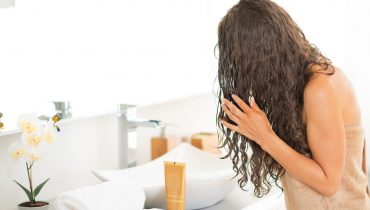Should I let the hair air-dry or should I use a dryer?
The majority of people I know choose a hair dryer because this solution is definitely faster and at the same time this tool facilitates styling the hair the way you want to. I often reach for a hair dryer too, even though I know that it may cause damage to my hair: it dehydrates hair, tangles it, makes hair static and deteriorates its condition. The key here is finding the compromise – a high quality hair dryer that doesn’t damage hair.
I devote today’s entry to the subject of hair dryers. I’m going to tell you how to recognize the good one and how to match it to your hair needs. Also, I’ll reveal a few secrets and I truly hope that I manage to debunk the myth saying that a hair dryer always harms the strands. Well, not always 🙂
To blow dry the hair or not to blow dry the hair? This is the question!
If I were to advise you and chose what’s better for hair, then I’d definitely say that it’s a world without hair dryers.
There is no use arguing with those who say that hair is the healthiest when allowed to dry at its natural pace. They are right because quick blow drying may encourage hair cuticles to open, which in turn leads to water loss. In the long run, this results in serious hair damage.
However, it should be realized that not everyone can let the hair dry on its own. Sometimes we lack time, but in most cases hair becomes unmanageable when not dried with this essential hair styling tool.
And this is what makes me a hair dryer supporter because my hair looks way better when I use the tool to help the strands dry. I believe that a high quality blow dryer – providing that it’s used correctly – shouldn’t damage hair. However, there’s always a risk, right?
Hair dryer not as black as it’s painted?
It’s impossible to count all the myths that have been created about hair dryers. The issue that is constantly repeated concerns the damage that this tool causes to hair. To be honest, I’m not so sure about it…
Indeed, hair doesn’t like being exposed to high temperatures because this makes the cuticles open, lose water and – together with the water – hair loses nutrients. Effect? Dehydrated, matte, rough, brittle hair with split ends. Of course this happens but only when we keep drying hair too frequently, using hot air stream and when we keep the blow dryer too close to hair.
When used correctly, a blow dryer:
- helps you style the hair
- closes and smooths out hair cuticles (cool air stream)
- improves the effects delivered by masks, conditioners and natural oils
- prevents frizzy hair (ionic hair dryer)
- may facilitate detangling
How to use a blow dryer to steer clear from hair damage?
- Set the right temperature – using medium-heat air stream you prevent the cuticles from opening, and this in turn prevents hair damage.
- Keep the blow dryer at a distance – if you don’t near the blow dryer too close the hair (approx. 8 inches), no damage should be caused.
- Don’t use full power of the blow dryer – the most common reason for tangled hair is setting the air stream to HIGH.
- Don’t blow dry the hair the opposite direction it grows – by drying hair from the top of the head downwards, so accordingly to the cuticle arrangement, you make the hair smooth, shiny and easy to detangle.
- Provide heat protection – it’s a really bad idea to use a blow dryer if the hair isn’t coated with a protective layer of a cosmetic shielding hair against a high temperature.
Blow dry technique vs. blow dryer type
What matters more: the technique we apply to dry the hair in or the tool we use for this procedure?
To me, it’s spread evenly 50/50. Even if you keep religiously following the above-mentioned rules (setting the right temperature, keeping the distance, etc.), you still can cause damage to the hair: you may end up with burned and static hair. This is what makes selecting the high quality tool so crucial. I know what blow dryer is the best one and what criteria should be followed while purchasing such hair styling tool.
The best blow dryer. How to find one?
“The more expensive, the better.” – This is exactly what my friend would say.
Well, no! A good hair dryer that doesn’t damage hair doesn’t have to cost a fortune. On the flip side, the cheapest devices aren’t the best solution either. I’d recommend you to take a look at the blow dryers that belong to the medium priced products group. Trust me, there are plenty of producers that offer really good devices to be used at home. Do you really need to have a professional blow dryer?
What should you pay attention to while choosing a blow dryer? There are a few aspects that I always bear in mind. In my view, a good blow dryer should have:
- this incredibly useful “ionic” property
- at least 3-level temperature setting
- cool air stream
- convenient size and light weight
- a rotating power cord
- certified quality
- neither too high nor too low power
Summary:
A blow dryer doesn’t damage hair if we use it correctly and treat hair with heat protection products prior to drying. What’s also important is the blow dryer that we choose – the best hair styling tools offer you temperature setting and are ionic.
I hope that now, after reading all my pieces of advice, choosing a blow dryer won’t cause you any problems. Kisses!


